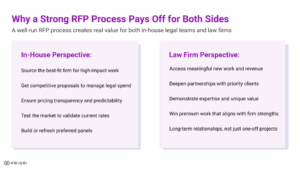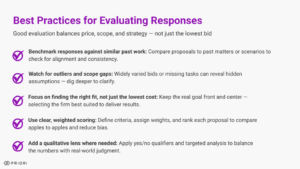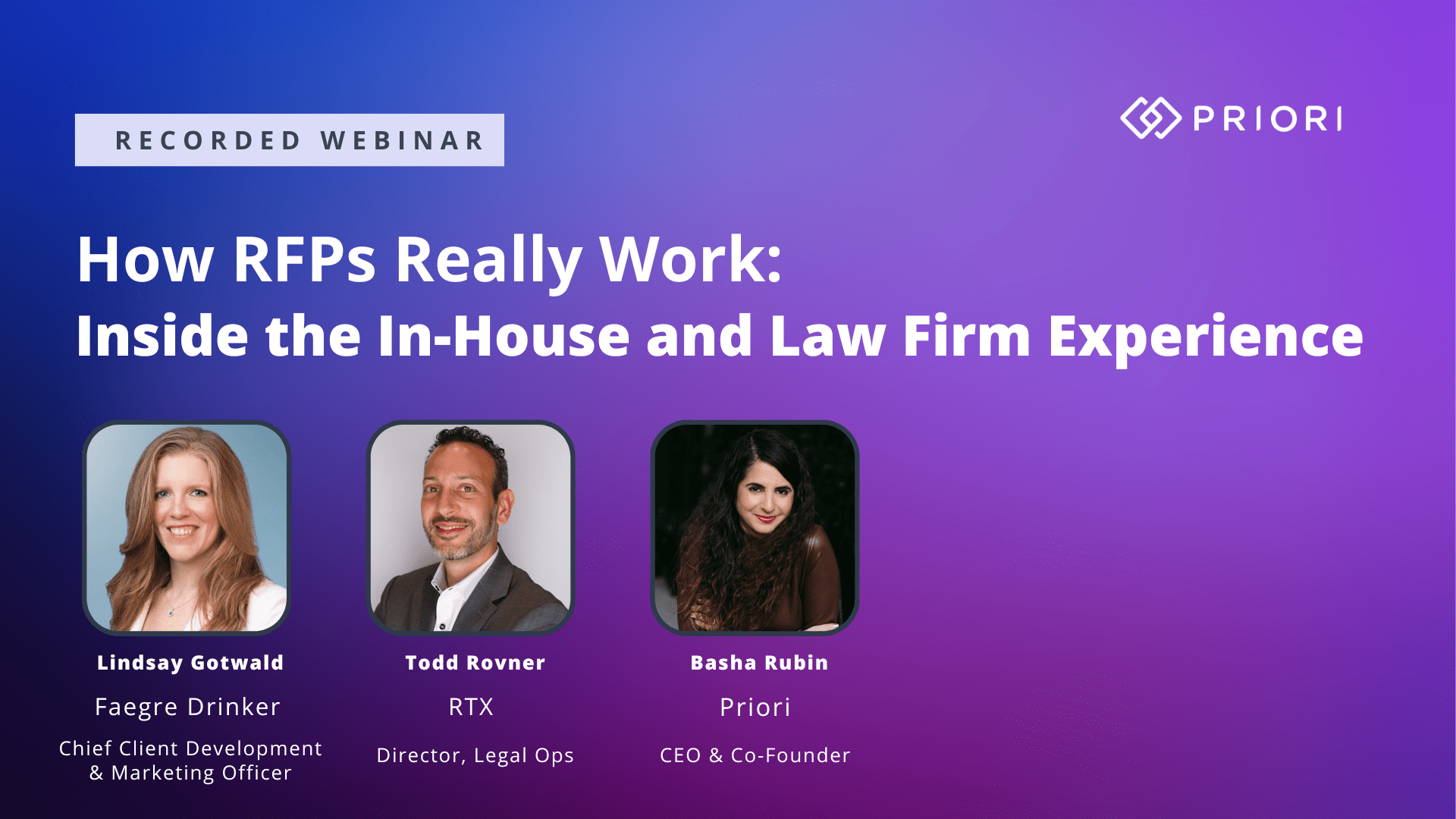Legal departments are increasingly turning to RFPs as a strategic tool, not just for cost control, but to build stronger partnerships and align on scope and timelines from the start.
That was the focus of our recent webinar, How RFPs Really Work: Inside the In-House and Law Firm Experience, featuring a candid conversation between leaders who brought both in-house and law firm perspectives to the discussion:
- Lindsay Gotwald, Chief Client Development & Marketing Officer, Faegre Drinker
- Todd Rovner, Director of Legal Ops, RTX
- Moderated by Basha Rubin, CEO & Co-Founder, Priori
Watch this short clip and view the full webinar recording on demand.
7 Takeaways on Legal RFPs From In-House and Law Firm Leaders
1. A Strong RFP Benefits Everyone
A successful RFP isn’t just a legal ops checkbox—it’s a strategic tool for creating alignment, driving performance, and cultivating trust between clients and firms. Done right, it can optimize pricing, encourage innovation, and help teams identify the right firm for the work. Done poorly, it can damage relationships and waste significant resources.
Both in-house teams and firms emphasized that strong RFPs foster transparency and mutual understanding. It’s not just about sourcing legal work—it’s about laying the foundation for long-term partnerships built on clarity, respect, and value.
Key points:
- RFPs unlock competitive pricing and strengthen client-firm trust.
- Poorly structured RFPs can harm even long-standing relationships.
- A disciplined process benefits everyone involved.
“When the RFP is done well, it is a great opportunity for us to show that we have the right relationships, the right expertise, to really help solve their legal or business challenges.” – Lindsay Gotwald, Faegre Drinker

2. Scope with Precision
The number one predictor of RFP success? Clarity of scope. Without a well-defined scope of work, firms can’t price accurately, clients can’t compare apples to apples, and everyone walks away frustrated. A strong scope includes deliverables, timelines, assumptions, exclusions, and success metrics—all aligned internally before the RFP goes out.
In-house legal teams should treat scoping as a collaborative effort with internal stakeholders. This not only improves RFP outcomes but also enhances accountability on both sides of the engagement.
Key points:
- Include detailed deliverables, assumptions, and exclusions.
- Engage stakeholders early to align on goals and expectations.
- Define what success looks like and how it will be measured.
“Without a clear scope, the result you get probably isn’t going to match what you expected.” – Todd Rovner, RTX
3. Quality Over Quantity in Firm Selection
One of the clearest takeaways from the webinar: don’t blast your RFP to 20+ firms. Instead, send it to a thoughtful shortlist of firms who are truly equipped to deliver on the work. This avoids wasted effort on both sides, signals respect for the firms’ time, and improves the quality of responses.
Firms that aren’t a good fit often appreciate the transparency of not being included. It also preserves goodwill, reduces fatigue, and ensures firms stay engaged and motivated when they are invited to participate.
Key points:
- Aim for 3–5 firms per RFP, plus ALSPs if relevant.
- Only include firms who could realistically win the work.
- Communicate clearly with those who are not invited.
“Don’t exercise everyone under the sun. Only send RFPs to firms that truly have a shot at it.” – Todd Rovner, RTX
4. Give Firms the Information (and Time) They Need
Behind every thoughtful RFP response is a huge investment of time, coordination, and expertise from the law firm side. Firms like Faegre Drinker mobilize entire cross-functional teams—client relationship managers, attorneys, practice leaders, pricing experts, innovation, DEI, HR, finance, and legal ops—just to prepare a single bid. That effort can range from $25,000 to over $100,000 in internal value, especially for complex or convergence RFPs.
That’s why clarity and lead time matter. Firms want to respond well, but they can’t do so effectively without clear expectations, transparent pricing formats, and a reasonable timeline.
Key points:
- Responses require coordination across 10+ internal teams at large firms.
- Fast turnaround RFPs (e.g., 72 hours) can compromise quality.
- Detailed RFPs help firms determine fit and allocate resources efficiently.
“We want to put our best foot forward, and we want you to get the most helpful responses from outside counsel to make the right choice. So a little more time often helps that.” – Lindsay Gotwald, Faegre Drinker
5. Evaluate on Best Value, Not Just Cost
While cost is a factor, it’s rarely the only one that matters. The panel emphasized using weighted evaluation frameworks that consider experience, strategy, operations, DEI, and cultural fit alongside pricing. At RTX, Todd Rovner’s team classifies work into three tiers—commodity, core, and critical—and adjusts scoring accordingly to reflect business impact.
This structured approach ensures consistent decision-making and helps internal stakeholders buy into the final selection. It also gives firms a fair shot at standing out based on their strengths.
Key points:
- Use tiered work classifications to adjust evaluation weightings.
- Include qualitative and operational criteria—not just pricing.
- Collaborate internally on scoring to ensure fairness and alignment.
“When you start evaluating—it is more than just cost. We employ a methodology called best value.” – Todd Rovner, RTX

6. Close the Loop—Every Time
One of the biggest frustrations firms cited is the lack of feedback after submitting a proposal. Even when they’re not selected, firms want to know why. Providing insights into scoring, pricing differentials, or specific gaps helps firms improve future responses and preserves trust in the relationship.
Post-matter feedback also benefits in-house teams. It surfaces scope mismatches, billing issues, and communication breakdowns—information that can refine future RFPs and vendor management practices.
Key points:
- Always notify selected and non-selected firms.
- Offer structured feedback with pricing and qualitative context.
- Conduct regular reviews during ongoing portfolio work.
“It’s all about improvement and maintaining relationships. Even if the firm isn’t selected, they deserve to know why.” – Todd Rovner, RTX
7. Be Real About ROI—But Think Bigger Than Price
Tracking RFP ROI isn’t as simple as comparing the highest and lowest bids. In-house teams should look beyond cost savings to consider actual billed amounts, adherence to budgets, and added value—like training, CLEs, or tech integrations. Panelists recommended normalizing for volume and complexity when calculating savings and tying RFP outcomes to matter management data when possible.
While savings help make the business case for structured RFPs, true ROI also includes strategic alignment, service quality, and better internal decision-making.
Key points:
- Compare results to historical spend and alternative bids—not just the highest one.
- Track project execution and change requests post-engagement.
- Factor in value-added services and relationship continuity.
“The win isn’t just the RFP response—it’s in the handoff, execution, and relationship that follows.” – Lindsay Gotwald, Faegre Drinker
Want to go deeper? Watch the full webinar on demand for actionable insights on RFP strategy, firm selection, evaluation frameworks, and more.
